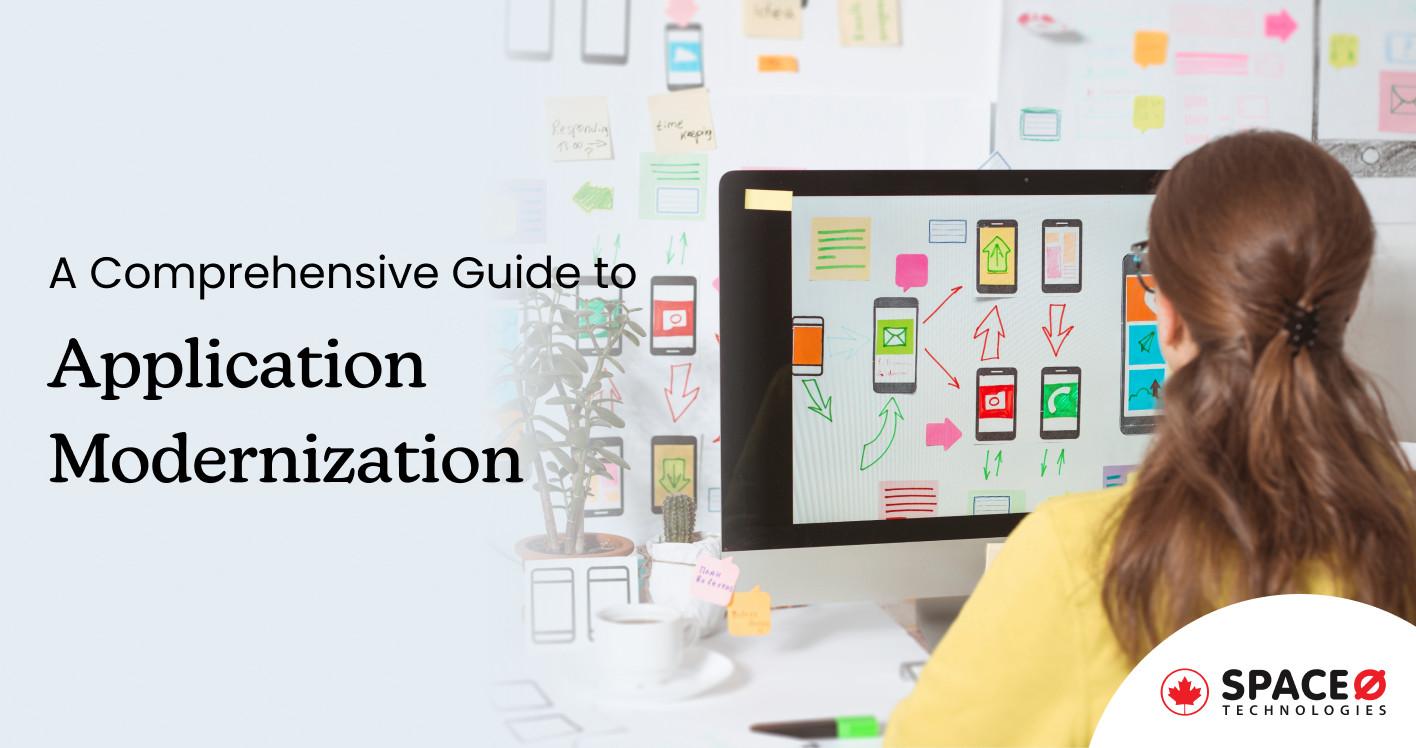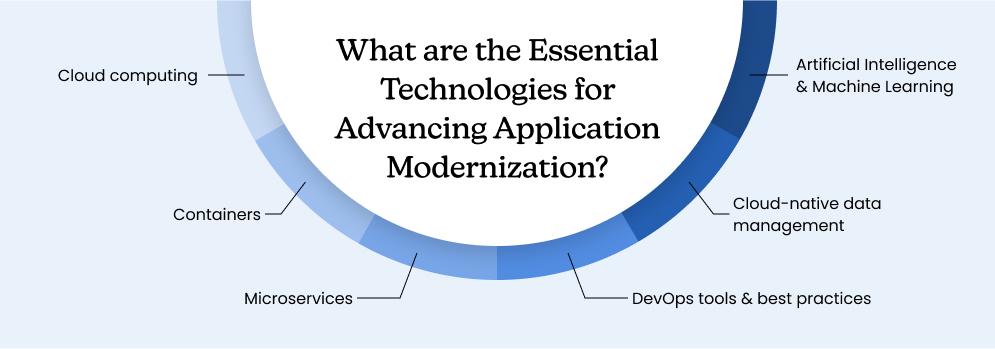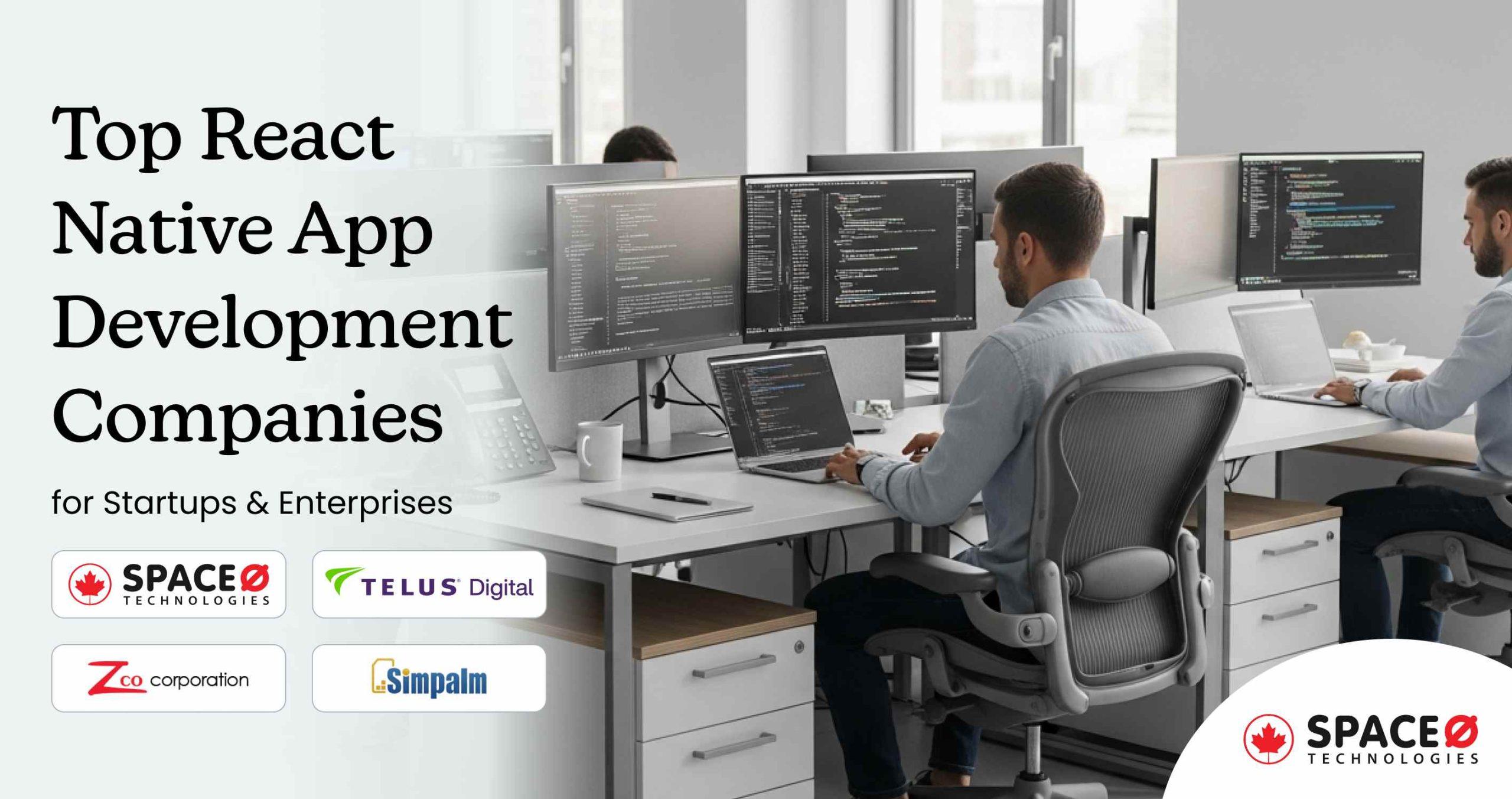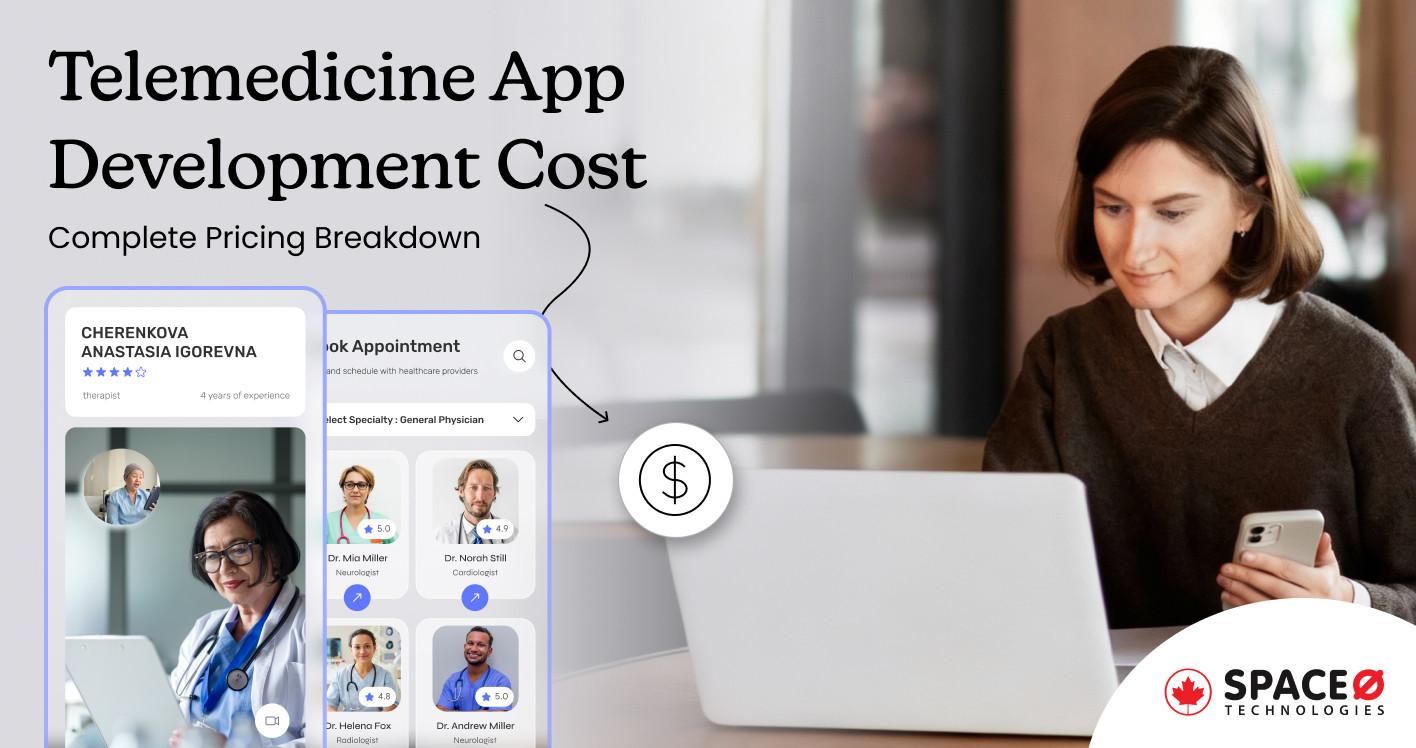
A Comprehensive Guide to Application Modernization
Application modernization is a staple need for organizations to keep up with the dynamic digital revolution. It involves transforming outdated applications, software, or systems to align with current business requirements, and leveraging the latest tech upgrades. Whether it’s an enterprise, business, or tech company, relying on legacy systems can deteriorate performance and escalate maintenance costs.
Therefore, switching to app modernization becomes key to overcoming suppressed growth, and other challenges. On the other hand, leveraging modern development frameworks with key technologies like AI, IoT, and machine learning unlocks the clogged potentials of legacy systems.
This blog is a synopsis of the fundamentals of:-
- What is application modernization and why do businesses need it?
- What are the tools used for modernizing applications?
- What are the key application modernization strategies?
- What are the latest application modernization trends?
What is Application Modernization? [Definition and Example]
Let’s breakdown the term “Application Modernization,”
In simpler terms ‘Application’ refers to an app, software, or data designed to serve the specific purpose of the users. While, ‘Modernization,’ in the tech context refers to upgrading, or transforming these systems, software, or processors to keep up with the pace of the latest tech innovations.
Application Modernization collectively refers to transforming, or upgrading legacy systems, and outdated application architectures, technologies, or processors aligning to business needs.
Certainly, there are two primary approaches to application modernization:
- Rehosting or migrating applications from an on-premises environment to cloud infrastructure or any other platform.
- Transformation can be done either by refactoring, rearchitecting, or replacing with SaaS.
To get a better understanding of application modernization, here’s an example:-
Situation: In a manufacturing unit, a legacy inventory management tool functions on outdated systems. With a lack of the latest tech stack, essential features, infrastructure, UI/UX, or integration capabilities, the organization is struggling with scalability, integrational, and mobile accessibility issues.
Now, how can the implementation of app modernization solutions help simplify operations?
Some of the measures to modernize existing apps are:-
- Assessment– Evaluating current pain points i.e., functionality, UI/UX, performance, security, and mobile accessibility.
- Cloud Migration– Migrating the system to a cloud-based platform to accelerate cloud adoption.
- Microservices Architecture– Rebuilding the monolithic legacy system to different components (inventory tracking, order processing, reporting).
- User Interface Upgrade– Redesigning the interface to make it more user-friendly
- Integrating Modern Tools– Integrating legacy systems with tools like Magento, and Shopify using APIs.
- Data Analytics– To gain real-time deeper insights (inventory levels, sales trends, customer preferences)
- Continuous Improvements– Maintaining DevOps culture for persistent integration & deployment.
This measure indicates how legacy application modernization services can help improve efficiency, flexibility, and user-friendly solutions to meet current business demands.
Did you know? 95% of enterprise-level organizations are either working on or planning to modernize their applications. Source: Integration Developer News
Now that we’ve clarified what application modernization entails, let’s look at the benefits it offers to businesses ready to transform their legacy application.
What are the Benefits of Application Modernization?

Embracing enterprise application modernization is a strategic investment, though it requires some upfront costs but it yields better results in the long term. Below are 7 key benefits of migrating your application system to a modernized platform.
-
Increases Efficiency
Adopting application modernization tools and frameworks helps to reduce operational costs, streamline operations, and automate processes. It not only boosts productivity but also accelerates delivery timelines. -
Improves Scalability
Implementing cloud-native architectures and technologies like containerization, helps businesses to manage demand fluctuations. Migrating to the cloud ensures optimal performance, reduced infrastructural costs, and relentless growth. -
Results in Greater Cost Savings
Accelerating toward cloud adoption, retiring unused features, leveraging open-source tools, automation, and advanced analytics brings down maintenance costs & reduces reliance on outdated hardware. Additionally, it optimizes the development processes. Enhances Security
Application modernization benefits in improved security protocols, because of the latest infrastructure and frameworks, which significantly reduces vulnerabilities.-
Relevance and Competitive Edge
Keeping up pace with the latest market changes & tech advancements allows businesses to remain agile and responsive to market demands. -
Improves User Journey & Customer Satisfaction
Modernizing applications drastically improves the speed and responsiveness of the existing system to ensure a seamless experience for employees and customers. -
Expands Revenue Streams
Businesses opting for modernized applications with modern features, like online payment options, enhanced customer support, or engaging digital experiences support monetary growth and expansion.
Looking to Modernize Your Legacy Applications?
Our team specializes in identifying the right technologies and designing a roadmap for successful application modernization.

Now that we know the benefits, let’s explore the key patterns that make application modernization possible.
What Are the Key Application Modernization Strategies?
Application modernization pattern refers to accelerating legacy applications while considering some of the common approaches and strategies to meet current tech needs and business demands.
The 4 R’s of app modernization patterns are:-
- Rehosting (Lift and Shift)
- Replatforming
- Refactoring
- Replacing
1. Rehosting (lift and shift): Definition, use case, benefits
Rehosting commonly known as lift and shift refers to moving the existing legacy application to a new environment with partially minimal or with no changes to the core code. This strategy revolves around moving to new infrastructure, i.e., a public cloud platform, while intending to least changes in the approach. The goal is to maintain optimal levels considering the application.
Use Case: Works well in the case of migrating promptly to new infrastructure like cloud technologies, but without changing the architecture of the existing application.
Benefits: Quick migration, minimal disruption, minimal cost
2. Replatforming: Definition, use case, benefits
Replatforming refers to modernizing applications to leverage the benefit of the modern infrastructure without overhauling the application architecture. It does not require major updates but necessitates upgrades such as modifications or replacing the application’s backend database. The goal is to achieve optimal performance of existing apps while also maintaining the code structure intact.
Use case: Replatforming is suitable for optimizing the performance or scalability of the application using cloud-native features.
Benefits: Limited changes to code, improved performance.
3. Refactoring: Definition, use case, benefits
Refactoring refers to “rewriting” or “restructuring” the application’s codebase. It involves switching an existing legacy application to a modern environment. This approach includes development efforts to retool the significant chunks of the underlying code to run in a new environment.
The major restructuring is of the existing codebase, which often requires rewriting the code. In this pattern, significant code changes are performed to often transform monolithic applications into smaller, decoupled pieces known as “Microservices.”
Use case: Refactoring becomes necessary to update the existing app to meet the modern needs and demands of the business.
Benefits: Improved scalability, performance, and maintainability.
4. Replacing: Definition, use case, benefits
Replacing involves completely retiring the existing applications or legacy system and adopting a new solution,i.e., off-the-shelf or cloud-based alternative. This pattern is typically opted when the existing applications or systems are too expensive to maintain, time-consuming, or technically impractical to meet technological advancements. By adopting this strategy organizations can reduce the complexity of refactoring.
Use case: When it becomes necessary to completely replace the old legacy system to rebuild a new one.
Benefits: Fast solution, reduced technical debt.
Understanding key patterns gives a solid foundation, but to realize its full potential it’s important to know essential technologies. Let’s explore the key technologies that help drive modernizing applications.
Get a Custom Application Modernization Strategy
Our expert team can help transform outdated systems into agile, scalable, and future-ready solutions. Let’s bring your app into the modern era.
What are the Essential Technologies for Advancing Application Modernization?

The essential technologies to modernize legacy applications efforts are:-
- Cloud computing
- Containers
- Microservices
- DevOps tools & best practices
- Cloud-native data management
- Artificial Intelligence & Machine Learning
1. Cloud computing
Cloud computing reduces the burden of on-premises infrastructure and eliminates complexities. Separating the traditional hardware, and adopting cloud benefits with scalability, automated resource management, and enhanced security. Leveraging cloud computing enterprises can achieve cost savings, enable rapid deployment, and grant access to the latest innovations. The key cloud computing technologies are:-
- AWS
- Microsoft
- Azure
- Google Cloud
2. Containers
Container package applications simplify the orchestration of complex multi-component applications. On the other hand, Kubernetes is an additional layer automating deployment, scaling, and enhancing fault tolerance. This combination simplifies the handling of multi-component applications, resulting in streamlined operations and resource utilization.
The key technologies of containers are:-
- Docker
- Kubernetes
3. Microservices
Separating monolithic applications into smaller independent microservices significantly improves agility and resilience. Additionally, microservices support to development, deployment, and scaling of each core function—also known as a service—individually leveraging the latest technological advancements. This approach allows scalable and targeted updates, minimizing the impact of overall downtime on the system. The key technologies of microservice integration are:-
- Spring Boot
- Micronaut
- Quarkus
4. DevOps tools & best practices
Embracing DevOps practices for application modernization projects, supported by CI/CD, configuration management, and infrastructure as code, increases the speed and reliability of software delivery. Such automated practices reduce the chances of human errors, ensuring rapid delivery of features, bug fixes, and minimal downtime. Some of the key DevOps tools that are widely used are:-
- Jenkins
- GitLab CI
- CircleCI
- Ansible
- Puppet
- Chef
5. Cloud-native data management
Upscaling your data storage and management approach with modern cloud platform solutions like cloud-based data warehouses, data lakes, and high-performance databases allows you to capitalize on your application capabilities. Some key technologies associated with cloud-native data management:
- Data processing frameworks
- Data integration and ETL tools
- Databases
- Microservices architecture
- Serverless computing
6. Artificial intelligence and machine learning
Integrating AI and ML capabilities enhances app modernization by enabling predictive analytics, automation, and personalization. Additionally, AI/ML tools improve user experience by offering data-driven recommendations and predictions. Overall, these capabilities improve performance and support organizations gain a competitive edge in the digital landscape.
Choosing the right technology and method for your system is paramount to achieving a successful application modernization strategy. Ensure that the decision aligns with your business objectives, tech expertise, and the nature of the application being modernized. A well-planned and executed legacy application modernization maximizes the ROI in investment and makes your system future-proof.
- TensorFlow
- PyTorch
- spaCy
- NLTK (Natural Language Toolkit)
- Google AI Platform
- Pandas
What are the Latest Application Modernization Trends?
When opting for an application modernization roadmap it is important to consider surveying the recent trends in your app modernization efforts. Here are some of the latest trends in application modernization:
1. Low-code and no-code development
Low-code and no-code development is the go-to solution for those with little programming skills. According to a report by Gartner, almost 70% of apps will be developed through low-code or no-code by 2025.
Why low-code & no-code development at the mainframe of modernization trends?
- Empowering devs
- Accelerating innovation
- Closing the talent shortage gap
Benefits:
- Accelerated innovation
- Addresses developer shortage
- Augments professional development
These platforms are ideally suitable for those looking forward to moving faster and quickly to modernize their systems.
2. Cloud-native development
According to a recent survey by Business Wire, 90% of all apps will be cloud-native by 2025. Cloud-native apps are developed on the foundation of microservices architecture. Such flexibility with software development solutions undergoes frequent upgrades to newer versions which results in continuous enhancements and cost-effective operations.
Benefits of cloud-native applications:
- Cost efficiency
- Increased flexibility
- Improved reliability
- Elevated customer experience
Imagine blending public and private clouds for your organization’s benefit. That’s hybrid cloud computing.
3. Hybrid cloud technology
A hybrid cloud offers a balanced blend of public clouds and privately owned clouds. This allows selecting the right cloud resource with full control and with the benefit of cloud scalability. Therefore, this technology is becoming favored in modernization policies due to the support of more than 70% of IT leaders (reported by Cloud Data Insights) who acknowledge it as a key digital transformation driver.
Benefits of hybrid cloud technology:
- Workload Optimization
- Data Management and Analytics
- Enhanced Security
- Disaster Recovery and Business Continuity
4. Composable architecture
The concept of composability is all about redesigning the system architecture based on user requirements. Companies apply composable architecture for the entire tech stack, integrated with all established business processes.
Opting for composable architecture offers benefits like:
- Flexibility and agility
- High-speed deployment
- Re-use capabilities
- Fewer duplication of data
5) Legacy infrastructure re-platforming, refactoring, and repurchasing
Replatforming focuses on leveraging cloud migrating techniques to improve key components instead of changing the core code of the system’s fundamental architecture.
Refactoring involves isolating monolithic application and their workloads to migrate them to serverless architecture while retaining the core code.
Repurchase is about advancing from one-time purchases to apps with recurring licenses.
Benefits of opting for re-platforming, refactoring, and repurchasing:
- Cost-effectiveness
- Performance and scalability
- Improved maintainability and agility
- Access to modern technologies
In conclusion, legacy systems can impede the growth of the enterprise. Therefore, considering application modernization as a strategic necessity is important to keep up in this tech landscape. Companies can understand their systems by following the best practices in application modernization and leveraging Space-O’s architectural insights. This will help them identify areas of technical debt to uncover opportunities for modernization.
Frequently Asked Questions
Why is application modernization risky?
Application modernization can be risky for several reasons including mission-critical applications, impact on developer productivity, and security concerns if not properly executed.
What is the advantage of having an application modernization partner?
An application modernization partner helps organizations address the complexities of modernizing legacy applications through their robust application modernization strategy to achieve better outcomes.
How can organizations balance cost efficiency and reduce risks during application modernization?
To mitigate the cost and reduce the risk of modernizing applications, it requires the following the best practices:-
- Standardized engineering,
- Reducing broken elements,
- Planning the transition, and
- Choosing the right approach.
How Space-O Can Help with Application Modernization
Space-O is the leading software development company specializing in modernizing legacy applications and addressing growing tech needs. With a deep understanding and spanning experience of both traditional systems and cutting-edge technologies, we design and deliver comprehensive, yet flexible solutions, to address organization-specific needs.
We aim to bridge the gap between old legacy systems and modern applications, to empower businesses to thrive in an evolving tech environment. Whether you’re:
- Planning to migrate to the cloud
- Looking to rearchitect your application or system for better scalability
- Aiming to improve current system performance with cutting-edge modern frameworks
Space-O offers end-to-end guidance to navigate through these transitions smoothly. We have successfully helped organizations transform their applications to achieve better performance, scalability, and resilience. This commitment has resulted in remarkable outcomes.
Our team of platforms and app modernization experts will assist you. Get in touch to make your system future-proof!

Modernize Legacy Systems.
Editor's Choice

Top React Native App Development Companies

Telemedicine App Development Cost: Complete Pricing Breakdown

Healthcare App Design: A Complete Guide for Building Better Medical Apps
All our projects are secured by NDA
100% Secure. Zero Spam
*All your data will remain strictly confidential.
Trusted by


Bashar Anabtawi
Canada
“I was mostly happy with the high level of experience and professionalism of the various teams that worked on my project. Not only they clearly understood my exact technical requirements but even suggested better ways in doing them. The Communication tools that were used were excellent and easy. And finally and most importantly, the interaction, follow up and support from the top management was great. Space-O not delivered a high quality product but exceeded my expectations! I would definitely hire them again for future jobs!”

Canada Office
2 County Court Blvd., Suite 400,
Brampton, Ontario L6W 3W8
Phone: +1 (437) 488-7337
Email: sales@spaceo.ca

